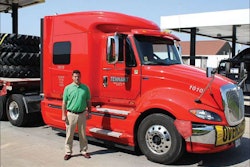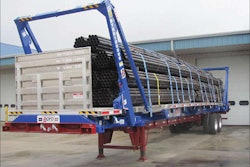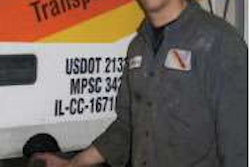Price-Tran develops business model to make LTL rates more simple, affordable
Price-Tran
Claysburg, Pa.
Deregulation of the trucking industry more than 30 years ago did nothing to simplify the rate structure of less-than-truckload carriers. If anything, LTL tariffs have become more complex.
Every carrier has unique tariffs that involve a complicated freight classification system, ZIP code pairs and price breaks – called discounts – for weight, miles, linear feet and other items. On top of this, carriers add on fuel and other accessorial charges.
Carriers and shippers are able to manage this complexity with technology. Many shippers use transportation management software to dissect LTL tariffs and compare apples to apples for freight bids.
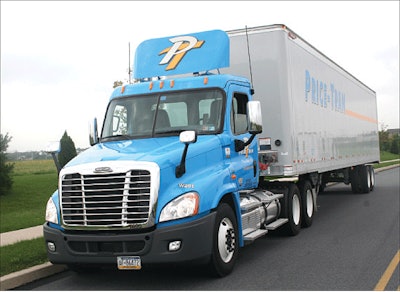
“We thought there was a better way to do this,” says Ward, who along with his wife, Liz, and two outside investors opened Price-Tran in March 2011. Price-Tran was designed and built from the ground up to be a “volume” LTL carrier to compete with “legacy” LTL carriers in price and service.
For simplicity, Price-Tran does not have tariffs; its system is based exclusively on pallet pricing. “It’s really about selling space in a trailer,” he says, offering the airline model as an analogy. Airlines do not care who occupies a seat, how tall they are or how much they weigh. “They charge what they charge per seat space,” Ward says. “We’re doing the same thing charging by pallet space.”
Pallet pricing is not a unique offering. Other LTL carriers offer similar programs, but Ward says the key difference is that Price-Tran places no restrictions on the weight, height, length or freight classification of pallets.
Filling a niche
Price-Tran focuses on shippers with freight conducive to pallet pricing. Customers that fit this mold have shipment sizes of six to eight pallets or “skids” – about three times the pallet count of an average LTL shipment.
For this niche market, Price-Tran has about half of the prospective business of an LTL carrier, but it claims a competitive advantage in price. The company can save shippers at least 15 percent on transportation costs, Ward says
Launched a new ‘volume LTL’ company and created a simple pricing program to eliminate the cost and complexity of LTL tariffs.
Unlike Price-Tran’s model, LTL carriers typically charge extra for pallets that weigh 1,500 pounds or more. They also may charge more for a 300-pound pallet depending on freight classification or the cubic dimension, he says.
Some LTL carriers will weigh and inspect freight consistently as it moves through their systems to upcharge shippers for discrepancies or exceptions to their pallet pricing programs. “Part of our motto is ‘The price we quote you is the price you pay,’ ” Ward says.
The fuel surcharge is another area of differentiation. Price-Tran’s fuel surcharge is calculated as a percentage of shipment revenue, as is standard in the LTL industry, but the company has set its rate at 20 percent less.
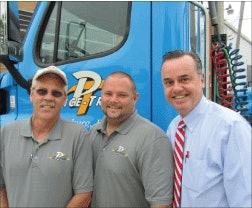 Dave Ward, right, with
Dave Ward, right, withemployees Tom Gerwig, left, and Craig Powers, says Price-Tran drivers do all of the unloading and reloading of freight themselves at the company’s two terminals.
Another difference is that its rate is tied to every 5-cent increase in the national average of diesel fuel; by comparison, some larger LTL carriers tie their surcharge to every 1-cent increase. This difference alone saves customers an additional two or three percent on fuel, says Darwin Mininger, pricing manager.
Offering a simplified pricing program has created challenges, however. About half of the shippers Price-Tran contacts say they are not able to analyze and determine their savings with pallet pricing. The TMS they use is geared toward analyzing cost savings for shipments tied to LTL tariff discounts.
That’s why Price-Tran works closely with many third-party logistics providers, which it has found are more likely to have the right tools and flexibility to break away from traditional LTL tariffs to analyze the savings the company can provide, Ward says.
Being a small family company also provides a service advantage. Ward has two sons that manage dispatch, and both of his daughters and wife are in marketing. The company also employs a pricing manager, a bookkeeper and three salespeople. The back office is lean, hands-on and focused.
“We went back to the basics of putting the customer first,” he says. “They have direct access to any of us.”
Cost advantage
The barrier of entry is high in the transportation industry, even for experienced fleet executives with business connections. Opening Price-Tran in March of last year required a “tremendous” amount of work over a six-month period, Ward says.
The startup process included an extensive market analysis of freight lanes and rates of competitors. Ward also wanted to create a trucking operation with as few capital assets as possible in order for Price-Tran to have a price advantage and to be able to focus its resources on sales and marketing.
“Part of our model is dependent on us having a cost advantage,” he says. “If we are going to play the price game, we better have a cost advantage.”
“We thought there was a better way to do this.”
– Dave Ward, Price-Tran
Finding vendors willing to make a bet on a startup company was difficult. Most national equipment leasing companies “didn’t want to talk,” Ward says.
Price-Tran currently has 16 trucks and 16 trailers, all new and under full maintenance leases; the trailer equipment is optimized for moving pallets. The company leased two terminals in Mansfield, Ohio, and Wilson, Pa., and opened a central dispatch office in Claysburg, Pa.
Both Price-Tran terminals are “dark” terminals, meaning they are unmanned facilities with the lights out during the day to keep overhead costs low. Drivers do all of the unloading and reloading of freight themselves at these locations after they pick up freight in the morning and leave to make deliveries.
“Drivers are professional, unsupervised employees that can run a location and satisfy customers in a productive and safe fashion,” Ward says. “We pay them well, but we demand a lot. We demand that they be responsible and autonomous.”
Each location has a lead driver that manages the routing of freight as directed by Price-Tran’s central dispatch office. Whereas LTL operations make 20 pickup-and-delivery stops per day, Price-Tran drivers make about 10 each, giving them the flexibility to do both local and line-haul work.
“They may be running pickup and delivery one week and line haul the next,” he says. “We try to do as much as we can to keep costs low.”
While focused on a market niche for now, Price-Tran is built to scale the company but keep its cost advantage to stay at the right price point in the marketplace. “We don’t want to be in a startup or small phase forever,” Ward says.
CCJ Innovators profiles carriers and fleets that have found innovative ways to overcome trucking’s challenges. If you know a carrier that has displayed innovation, contact Jeff Crissey at [email protected] or 800-633-5953.




